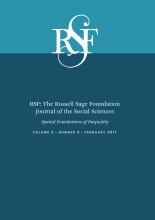Research Article
Open Access
Socioeconomic Segregation of Activity Spaces in Urban Neighborhoods: Does Shared Residence Mean Shared Routines?
Christopher R. Browning, Catherine A. Calder, Lauren J. Krivo, Anna L. Smith, Bethany Boettner
RSF: The Russell Sage Foundation Journal of the Social Sciences February 2017, 3 (2) 210-231; DOI: https://doi.org/10.7758/RSF.2017.3.2.09
Christopher R. Browning
aProfessor of sociology at the Ohio State University
Catherine A. Calder
bProfessor of statistics at the Ohio State University
Lauren J. Krivo
cProfessor of sociology at Rutgers University
Anna L. Smith
dPhD candidate in statistics at the Ohio State University

REFERENCES
- ↵Allport, Gordon W. 1954. The Nature of Human Prejudice. Boston, Mass.: Addison-Wesley.
- ↵
- ↵Bischoff, Kendra, and Sean F. Reardon. 2014. “Residential Segregation by Income, 1970–2009.” In Diversity and Disparities: America Enters a New Century, edited by John Logan. New York: Russell Sage Foundation.
- Bitler, Marianne, and Christine Peterson. 2004. “LAFANS Income and Asset Imputations: Description of Imputed Income/Assets Data for LAFANS Wave 1.” Santa Monica, Calif.: RAND Corporation.
- ↵Blalock, Hubert M., Jr. 1967. Toward a Theory of Minority-Group Relations. New York: John Wiley & Sons.
- ↵
- Bobo, Lawrence D
- ↵
- Brophy, Paul C., and
- Rhonda N. Smith
- Browning, Christopher R.,
- Catherine A. Calder, ,
- Brian Soller, ,
- Aubrey L. Jackson, , and
- Jonathan Dirlam
- ↵
- ↵
- Cameron, Stuart
- ↵
- Casciano, Rebecca, and
- Douglas S. Massey
- ↵
- ↵
- ↵
- ↵
- Emerson, Michael O.,
- Rachel Tolbert Kimbro, , and
- George Yancey
- ↵
- Fischer, Mary J
- ↵
- ↵
- Galster, George,
- Roger Andersson, ,
- Sako Musterd, , and
- Timo M. Kauppinen
- ↵Galster, George, Jackie Cutsinger, and Jason C. Booza. 2006. “Where Did They Go? The Decline of Middle-Income Neighborhoods in Metropolitan America.” Metropolitan Policy Program. Washington, D.C.: Brookings Institution Press.
- ↵
- Hipp, John R
- ↵
- Hipp, John R., and
- Andrew J. Perrin
- ↵Jargowsky, Paul A. 2013. “Concentration of Poverty in the New Millennium: Changes in Prevalence, Composition, and Location of High-Poverty Neighborhoods.” New York and Camden, N.J.: Century Foundation and the Center for Urban Research and Education.
- ↵Jargowsky, Paul A., and Todd Swanstrom. 2009. Economic Integration: Why It Matters and How Cities Can Get More of It. City Vitals Series. Chicago: CEOs for Cities.
- ↵
- ↵
- ↵
- Kleit, Rachel Garshick, and
- Nicole Bohme Carnegie
- ↵
- Krivo, Lauren J.,
- Heather M. Washington, ,
- Ruth D. Peterson, ,
- Christopher R. Browning, ,
- Catherine A. Calder, , and
- Mei-Po Kwan
- ↵
- Lees, Loretta
- ↵Lees, Loretta, Tom Slater, and Elvin Wyly. 2008. Gentrification. New York: Routledge.
- ↵
- Levy, Diane K.,
- Zach McDade, , and
- Kassie Bertumen
- ↵
- Massey, Douglas S., and
- Mary J. Fischer
- ↵
- ↵Palmer, John R. B. 2013. “Activity-Space Segregation: Understanding Social Divisions in Space and Time.” PhD diss., Princeton University.
- ↵
- Parker, Robert Nash, and
- Rudy Fenwick
- ↵
- Pettigrew, Thomas F
- ↵
- Pettigrew, Thomas F., and
- Linda R. Tropp
- ↵
- Putnam, Robert D
- ↵
- ↵
- ↵
- Rosenbaum, James E.,
- Linda K. Stroh, , and
- Cathy A. Flynn
- ↵
- Sampson, Robert J., and
- Dawn Jeglum Bartusch
- ↵
- Sastry, Narayan,
- Bonnie Ghosh-Dastidar, ,
- John Adams, , and
- Anne R. Pebley
- ↵
- Tach, Laura M
- Tach, Laura M
- ↵
- Talen, Emily
- ↵
- Taylor, Marylee C
- Thomas, Vinod, Yan Wang, and Xibo Fan. 2001. “Measuring Education Inequality: Gini Coefficients of Education.” Working Paper no. 2525. Washington, D.C.: World Bank.
- ↵
- van Duijn, Marijtje A. J.,
- Tom A. B. Snijders, , and
- Bonne J. H. Zijlstra
- ↵
- Walks, R. Alan, and
- Richard Maaranen
- ↵
- Wilkinson, Richard G., and
- Kate E. Pickett
- ↵
- ↵
- Zubrinsky, Camille L., and
- Lawrence Bobo
In this issue
Socioeconomic Segregation of Activity Spaces in Urban Neighborhoods: Does Shared Residence Mean Shared Routines?
Christopher R. Browning, Catherine A. Calder, Lauren J. Krivo, Anna L. Smith, Bethany Boettner
RSF: The Russell Sage Foundation Journal of the Social Sciences Feb 2017, 3 (2) 210-231; DOI: 10.7758/RSF.2017.3.2.09
Socioeconomic Segregation of Activity Spaces in Urban Neighborhoods: Does Shared Residence Mean Shared Routines?
Christopher R. Browning, Catherine A. Calder, Lauren J. Krivo, Anna L. Smith, Bethany Boettner
RSF: The Russell Sage Foundation Journal of the Social Sciences Feb 2017, 3 (2) 210-231; DOI: 10.7758/RSF.2017.3.2.09
Jump to section
Related Articles
- No related articles found.
Cited By...
- No citing articles found.





